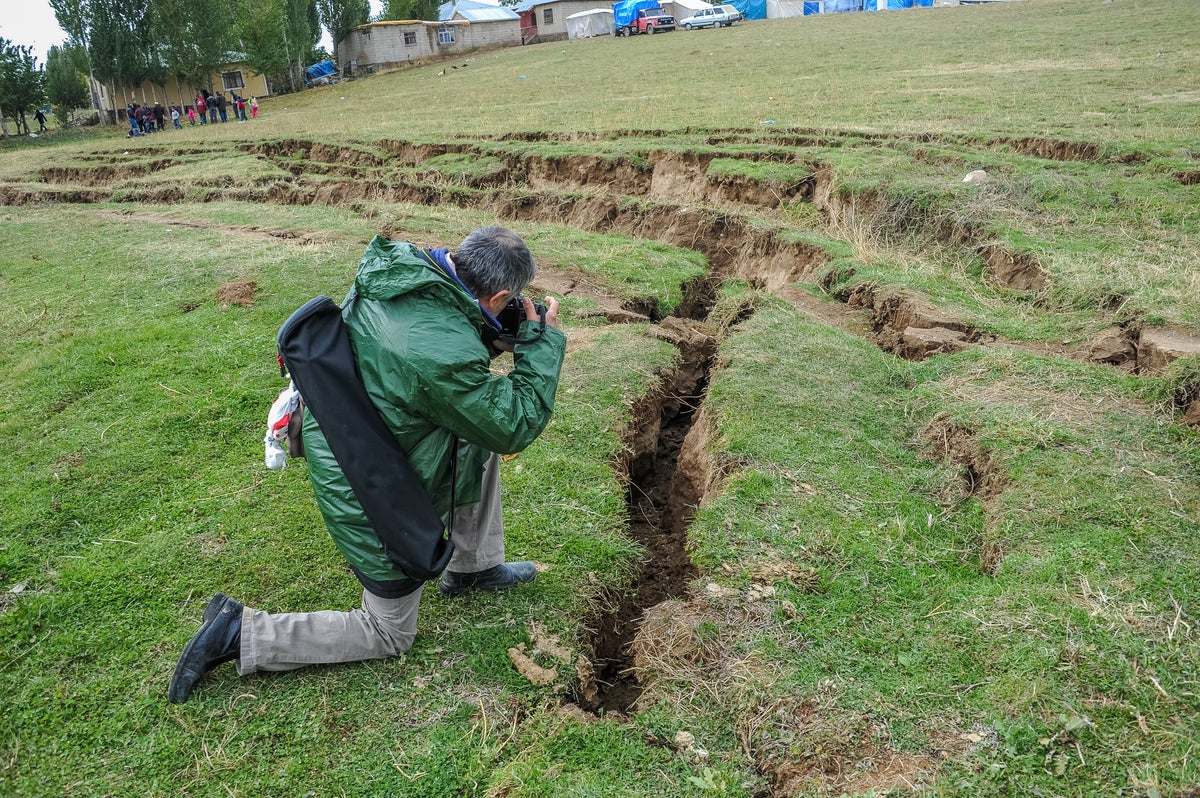
The UK is hit by hundreds of earthquakes every year, experts have revealed, as they say the country is ‘riddled’ with fault lines.
The British Geological Survey (BGS) told The Independent as many as 300 earthquakes impact the UK each year, with around a tenth of those being large enough to be felt by people near the epicentre, while the others are detected by sensitive instruments.
The 3.3 magnitude earthquake that rocked the country at 8.21pm on Wednesday is one of the roughly three larger tremors that affect the UK every year, according to BGS seismologist David Hawthorn.
The number and magnitude of earthquakes in Ireland and Great Britain over the last few decades shown on a map that also shows the variation in thickness of plate— (Raffaele Bonadio)
It had an epicentre 7.3km below the village of Tean, with people living in Staffordshire reporting “an initial rumbling, then a bang” as well as rattling windows and doors.
But while an earthquake of this size in the UK is a “reasonably uncommon” occurrence, it is “totally within the normal parameters” and “not out of the ordinary”, he said.
Sergei Lebedev, Professor of Geophysics at the University of Cambridge, agreed that a tremor of a magnitude over three is “fairly common”. He said: “Above three is not a microearthquake - which are very common - and is felt and can cause minor damage so, of course, is a concern. But Wednesday’s tremor was in an area where they are quite common. These earthquakes don’t occur every day, but on a 10-year scale they are fairly common.”
In fact, earthquakes, in general, are not extraordinary events in this country, Mr Hawthorn added, explaining: “The fault map of the UK looks insane - we’re just riddled with plains of weakness. Geologically speaking, the UK has four or five different land masses, all of which have been squeezed together over many years - so there are faults between the land masses and then there are multiple faults on the land masses themselves.”
A map shows faults in the UK that we know about and that are big enough to show up on such a large-scale map— (BGS © UKRI )
Most earthquakes are associated with tectonic plate boundaries and are caused by the tectonic stress transmitted from plate boundaries, according to Mr Lebedev.
Earthquakes are not increasing in frequency in this country either, Mr Hawthorn said. “People often think there are more earthquakes with each year, but it’s just that we’ve got better at reporting them.”
Natural earthquakes occur at a very constant rate, whereas human-induced earthquakes will vary depending on what is happening at the time, he explained, citing the “huge number” of earthquakes in Stoke-on-Trent when the area was devoted to coal mining.
A map shows the different rock types that make up the UK, such as granite and limestone— (BGS © UKRI )
Mr Lebedev similarly said earthquakes occur at a “very constant” rate in the UK, so there is no expectation that tremors will become more or less common in the future after Wednesday night’s quake.
However, while it is possible to make predictions of frequency, the BGS thinks it is in all likelihood not possible to predict earthquakes. This is partly due to the “incredibly complicated system” of the various fault lines, as well as the depth at which earthquakes occur, often 10km down into the earth, said Mr Hawthorn.
“It is phenomenally difficult to work out where earthquakes will occur,” he said. “There could be another earthquake right now, or there might not be another for 10 years.”
But, while the timing of when an earthquake might happen is “random”, Mr Lebedev, who is currently researching where and why earthquakes happen in the UK, said: “We cannot predict - earthquake prediction is what magicians do - but we can forecast where they might happen.”
He explained forecasts can be made based on where earthquakes have occurred in the past as well as the thickness of tectonic plates.
The area where the earthquake hit on Wednesday is located on a thinner plate, which therefore means more tremors are likely to happen there.
The tremor that struck on Wednesday night is the largest of 21 earthquakes to hit the UK in the last two months, comfortably beating two 1.8 magnitude tremors felt on the Isle of Mull in May.
It falls some way short of the record earthquake in the UK, which the BGS records as a 6.1 magnitude tremor in the North Sea, about 75 miles north east of Great Yarmouth, on June 7 1931.
Filey felt the strongest effects of that earthquake, with a church spire rotated, which was felt as far away as Surrey, Norway, Denmark and Germany
Mark Begg, 30, said he was at home in Uttoxeter when he felt "a very large shake".
He said he checked "around the house to see if I could see anything" and "after noticing there were no signs of damage I concluded it was most likely a mini earthquake".
Tom, 38, in Cheadle, Staffordshire, said: "I was sitting watching an episode of Only Connect with my wife on YouTube and as we opened another bottle of wine the whole house shook.
"I thought either one of the children had fallen out of bed or something else had happened."







